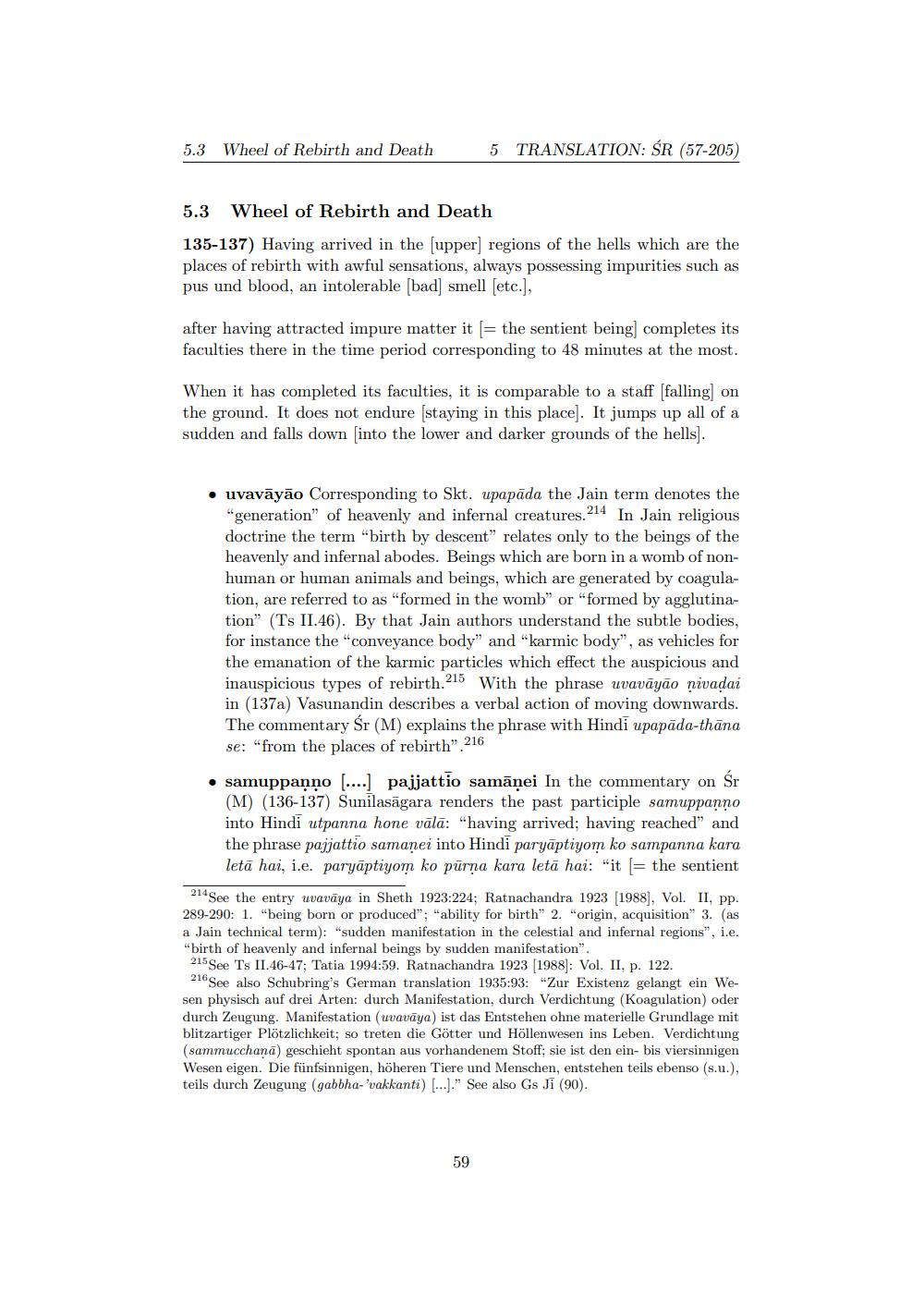________________
5.3 Wheel of Rebirth and Death
5 TRANSLATION: ŚR (57-205)
5.3 Wheel of Rebirth and Death
135-137) Having arrived in the [upper] regions of the hells which are the places of rebirth with awful sensations, always possessing impurities such as pus und blood, an intolerable [bad] smell [etc.],
after having attracted impure matter it [= the sentient being] completes its faculties there in the time period corresponding to 48 minutes at the most.
When it has completed its faculties, it is comparable to a staff [falling] on the ground. It does not endure (staying in this place]. It jumps up all of a sudden and falls down [into the lower and darker grounds of the hells].
⚫uvavãyão Corresponding to Skt. upapada the Jain term denotes the "generation" of heavenly and infernal creatures. 214 In Jain religious doctrine the term "birth by descent" relates only to the beings of the heavenly and infernal abodes. Beings which are born in a womb of nonhuman or human animals and beings, which are generated by coagulation, are referred to as "formed in the womb" or "formed by agglutination" (Ts II.46). By that Jain authors understand the subtle bodies, for instance the "conveyance body" and "karmic body", as vehicles for the emanation of the karmic particles which effect the auspicious and inauspicious types of rebirth.215 With the phrase uvavāyāo nivaḍai in (137a) Vasunandin describes a verbal action of moving downwards. The commentary Śr (M) explains the phrase with Hindi upapada-thāna se: "from the places of rebirth".216
samuppanno [....] pajjattio samānei In the commentary on Śr (M) (136-137) Sunilasägara renders the past participle samuppanno into Hindi utpanna hone vala: "having arrived; having reached" and the phrase pajjattio samanei into Hindi paryaptiyom ko sampanna kara
leta hai, i.e. paryaptiyom ko purna kara leta hai: "it [= the sentient
214See the entry uvavaya in Sheth 1923:224; Ratnachandra 1923 [1988], Vol. II, pp. 289-290: 1. "being born or produced"; "ability for birth" 2. "origin, acquisition" 3. (as a Jain technical term): "sudden manifestation in the celestial and infernal regions", i.e. "birth of heavenly and infernal beings by sudden manifestation".
215 See Ts II.46-47; Tatia 1994:59. Ratnachandra 1923 [1988]: Vol. II, p. 122. 216 See also Schubring's German translation 1935:93: "Zur Existenz gelangt ein Wesen physisch auf drei Arten: durch Manifestation, durch Verdichtung (Koagulation) oder durch Zeugung. Manifestation (uvavāya) ist das Entstehen ohne materielle Grundlage mit blitzartiger Plötzlichkeit; so treten die Götter und Höllenwesen ins Leben. Verdichtung (sammucchana) geschieht spontan aus vorhandenem Stoff; sie ist den ein- bis viersinnigen Wesen eigen. Die fünfsinnigen, höheren Tiere und Menschen, entstehen teils ebenso (s.u.), teils durch Zeugung (gabbha-'vakkanti) [...]." See also Gs Ji (90).
59




